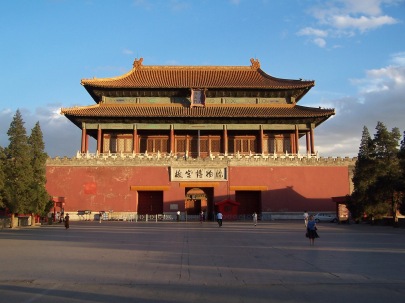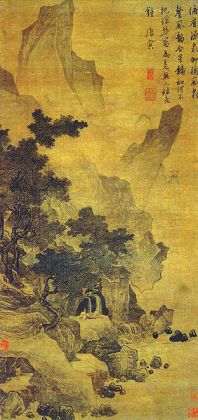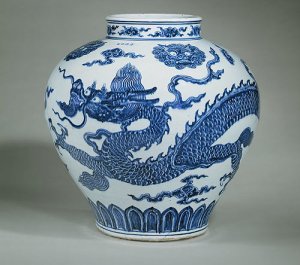When we focus on Western civilization and art, it is hard to think there were other significant cultures out there other than ours. After all, the United States hadn’t been born yet and renaissances and exciting changes were taking place in Europe so it is easy to believe that this was the only significant civilization on the planet at the time. This is not the case. The Ming dynasty ruled eastern China for 276 years from 1368 to 1644. It is sometimes regarded as the one of the greatest eras of orderly government and social stability in human history.
Forbidden City, Ming dynasty
Built in 1406 to 1420, it is hard to know who the direct architect of the Forbidden City was. The Forbidden City, located in Beijing, was an imperial palace for many of the Ming dynasty emperors and forbidden to the general public, hence the name. The Forbidden City is almost just that, a city. It consists of 980 surviving buildings that cover 180 acres. What makes this piece so great is that is exemplifies traditional Chinese palatial architecture. When thinking of the architecture that came out of this era on this side of the world, this is the style seen and shown in history books and movies today. It not only has had a lasting impact on today, but also at the time with neighboring cultures. It has had strong influences in Korea, Vietnam, and Japan. It is also phenomenal that this traditional architecture style is still used in modern day, although due to the growing economies and growing cities, demand for high speed construction and higher floor area ratio means that this style has declined in recent years. Overall, this is probably one of the greatest non-Western pieces of all time. One unique thing about this style of architecture is the tiered roof. If you notice, below the main roof there is one some times two other tiers of roofing after that. Another feature of the Forbidden City is bilateral symmetry. If you notice, the complex itself is symmetric down the center. This is seen everywhere in Chinese architecture. This symmetry symbolizes balance. Being half Chinese, I love this style of architecture. Maybe I am a little biased. Not the only the details, but the symbolism as well make this work fascinating. Overall, this style of architecture is so phenomenal that I could post my entire post about just this style of art. Unfortunately, I can’t. I’ll let you looks at the pictures and observe the greatness yourself.
Watching the Spring and Listening to the Wind by Tang Yin
This next piece is called Watching the Spring and Listening to the Wind by Tang Yin. Born in 1470, Tang Yin was a renowned Chinese scholar, painter, calligrapher, and poet of the Ming dynasty. Although Tang Yin was a talented man, we will focus on the beauty of his artwork. To generalize his artwork, they usually encompassed an expansive landscape accompanied by calligraphy somewhere on the painting in and ink and wash style. One of my favorite elements of this piece is the incorporation of the paper and the fading of the background into this paper. The effect seems to suggest there is fog in the background or that the background melds seamlessly into the paper. The foreground, however, is flawless with detail. This style of painting is very classic Chinese. The paper style also adds great affect to this painting. Imagine this same painting completed on a white piece of paper or background. I think that we could all agree that it just wouldn’t look right. It could be the case that the paper has faded and worn over the tested time of history, but I like to think that this was purposefully done as I truly believe that the paper brings elements of the painting that compliment the rest of it. Aesthetically, I really enjoy this piece. If I heard the words “classic Chinese painting”, this is instantly the kind and style of painting I would think of. Overall, the aesthetics are gorgeous. When observing this paining, it seems very calming and relaxed. As the name suggests, its like I am watching the spring and listening to the wind.
Jar, Ming dynasty, Xaunde era (1426-1435)
The last type of art I want to note from the Ming dynasty is not architecture and not paintings, but a little bit of both. It is the pottery and porcelains of the Ming dynasty. This example here is of a jar created during the Ming dynasty. It has the Xuande mark indicating it was probably created between 1426 and 1435 from the Xuande era. Many of these porcelains during this period were so recognized that in the western world, they were just called “Ming”s. This piece is fascinating because of its sophistication. It exudes a sense of freedom and energy. The reason why I am so drawn to this piece is that we had these style vases, bowls, and other porcelains around the house! I got to see them everyday and didn’t think anything of it. Now learning the background of the artwork that was once in my house is awesome. Just like in this piece, our porcelains exhibited works or dragon and were painted extremely similar to that of this one here. Just as this piece, the dragon seemingly moved around the piece commanding its presence. The style of dragon was even the same with sharp back spines and strong features in the face. Overall, I really like this piece due to the connection with my childhood and I hopefully can go back to China one day to see all the works seen above.
Works Cited
“Chinese Architecture.” Wikipedia. Wikimedia Foundation, 27 July 2014. Web. 06 Aug. 2014. <http://en.wikipedia.org/wiki/Chinese_architecture>.
“Heilbrunn Timeline of Art History.” Jar [China] (37.191.1). N.p., n.d. Web. 06 Aug. 2014. <http://www.metmuseum.org/toah/works-of-art/37.191.1>.
“Ming Dynasty.” Wikipedia. Wikimedia Foundation, 08 May 2014. Web. 06 Aug. 2014. <http://en.wikipedia.org/wiki/Ming_dynasty>.
“Tang Yin.” Wikipedia. Wikimedia Foundation, 27 July 2014. Web. 06 Aug. 2014. <http://en.wikipedia.org/wiki/Tang_Yin>.




I am similarly impressed by 3D Street Art. It is truly incredible, especially the careful planning that must go into very piece so that the angles and perspective is just right. One aspect that I find especially remarkable is the fact that artists incorporate objects into their works, as you pointed out. A great example of this is the snail’s antenna. I’m amazed that you noticed this, because I had looked at this piece without noticing. Great catch!
I’m glad that you included Mueller’s Cave Drawing from two perspectives. It’s amazing that from one angle, it looks like a real cave right there on the street, but from a different perspective, it has no distinguishable shape.
One of my favorite works of street art is Push the Boat Out by Julian Beever. It depicts a perfectly smooth pond with water that has the iridescence of a smooth lake. One side has the beginning of a ripple as a man seems to poke the water. I love that Beever incorporates the actual man to make the piece interactive.
Sorry, I posted this in the wrong section on accident. I meant to post this!
I really appreciated our background information about the Forbidden City. I agree with your appreciation of symmetry in this architecture. I find symmetry visually appealing, and I agree with the Chinese idea that it symbolizes balance. My favorite work in this exhibit is Watching the Spring and Listening to the Wind. It is incredibly detailed, yet simple in its overall composition. I am drawn to how the various aspects of this piece seem to flow seamlessly into each other, such as the trees, rocks, and mountains. I also agree with your opinion that the paper style is vital in giving this piece its beauty and cohesiveness. It was great to read your blog and use the links you provided to learn more about Chinese art and culture.
I do agree that after mainly focusing on Europe and America and all that went on there it’s hard to believe that there is so much that we missed from other places like China. I really enjoyed your analysis of each of the works you presented to us, they were very detailed. I also really enjoyed looking at the Chinese architecture, first of all because it is so unique and secondly I really enjoy things that are symmetrical and the forbidden palace fits perfectly into that criteria. Here is a link to more information on Ming Dynasty architecture. http://english.cri.cn/1702/2005-4-28/14@207622.htm
It represents thee addition of three Imperial Tombs of the Qing Dynasty in Liaoning
to the Ming tombs inscribed in 2000 andd 2003. The Three Imperal Tombs of
the Qing Dynasty in Liaoning Province include the Yongling Tomb, the Fuling Tomb, and the Zhaoling Tomb, all built in the 17th century.
Constructed for the founding emperors of the Qing Dynasty and
their ancestors, the tombs follow the precepts of traditional
Chinese geomancy and fengshui theory. They feature
rich decoration of stone statues andd carvings and tiles with
dragon motifs, illustrating the development of the funerary architecture of thee
Qing Dynasty. The three tomb complexes, and their njmerous edifices, combine traditions inherited from previous dynasties and
new features of Manchu civilization.